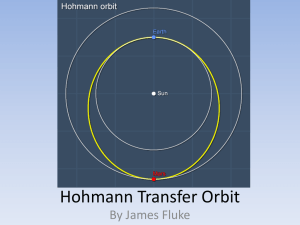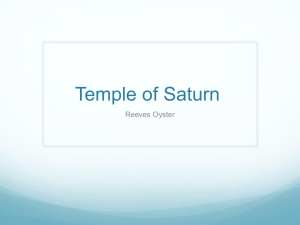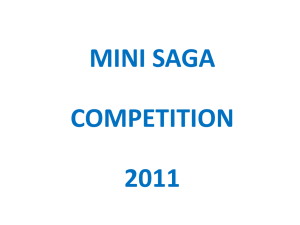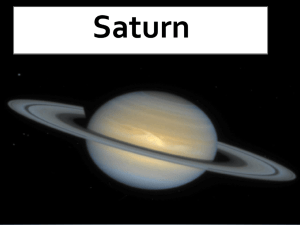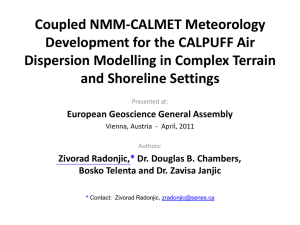Presentation
advertisement
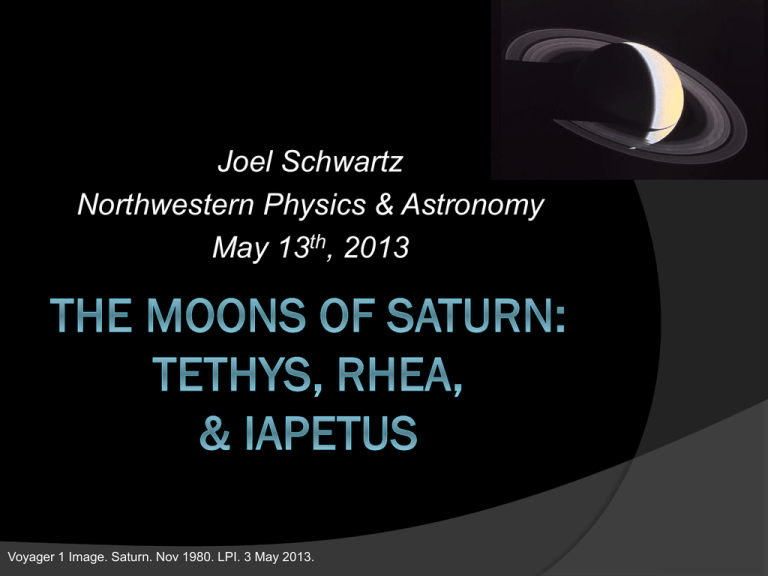
Joel Schwartz Northwestern Physics & Astronomy May 13th, 2013 Voyager 1 Image. Saturn. Nov 1980. LPI. 3 May 2013. Moons of Solar System. NASA SSE. 3 May 2013. Discovery All three satellites were first observed by Giovanni Cassini. Iapetus: October 25th, 1671 Rhea: December 23rd, 1672 Tethys: March 21st, 1684 These moons & Dione were originally called Sidera Lodoicea (The Stars of Louis) by Cassini, after Louis XIV. Orbital Locations Orbital Diagram of Saturn Moons. 2004. U. Cincinnati Physics- Gas Giants. 4 May 2013. Etymology Associated with siblings of Kronos, as suggested by John Herschel. Tethys: Sister of Kronos & wife of Oceanus. Linked to rivers & water. Rhea: Wife/Sister of Kronos. Referred to as the “Mother of the Gods.” Iapetus: Brother to Kronos; father of Atlas & Prometheus. Considered the “Father of the Human Race” by the ancient Greeks. Greek Titans Greek Titans (Various). Wikipedia. 4 May 2013 Previous/Current Space Missions Pioneer 11: August-September 1979 Voyager 1: November 1980 (no Iapetus flyby) Voyager 2: August 1981 Cassini-Huygens: July 2004 & onward Initial images by Voyager 1 & 2, then more detailed photography by CassiniHuygens. Tethys (Saturn III) Radius: 531.1km Density: 985 kg/m^3 Vis. Geo. Albedo: 0.8 Semimajor Axis: 294.7k km Period: 1.888 days (tidally locked) Inclination: 1.88° Cassini Image. Tethys. National Space Science Data Center. 4 May 2013. Tethys (cont.) Heavily cratered, but not to the extent of Rhea. Largely water-ice with small amounts of rock. Gravitationally holds Telesto & Calypso. Quite noticeable is Odysseus Crater, prominent in the Western Hemisphere. Cassini Image. Tethys with Odysseus Crater. NASA SSE. 4 May 2013 Tethys (cont.) Has a high visual geometric albedo. Is bombarded by water-ice particles from geysers on Enceladus. Has the Ithaca Chasma running roughly from the north to south pole. Voyager 2 Image. Tethys with Ithaca Chasma. 26 Aug 1981. NSSDC. 4 May 2013. Composite Spectroscopy Data A Pair of Pac-Men. 26 Nov 2012. NASA SSE. 4 May 2013. Rhea (Saturn V) Radius: 763.8km Density: 1240 kg/m^3 Vis. Geo. Albedo: 0.7 Semimajor Axis: 527.04k km Period: 4.5175 days (tidally locked) Inclination: 0.35° Cassini Image. Portrait of a Lady. 10 Mar 2013. NASA SSE. 4 May 2013. Rhea (cont.) Voyager 1 Image. Rhea Mosaic. Nov 1980. NSSDC. 3 May 2013. Cold body with tenuous atmosphere; similar to Tethys. Density suggests ¾ water-ice, ¼ rock, and homogeneous. Due to distance from Saturn, Rhea does not receive significant tidal heating effects. Rhea (cont.) Large amount of craters, which can be subdivided into two regions: Heavy cratered bright terrain with diameters above 40km. Polar & equatorial areas with smaller diameter craters. “Wispy” subsidence fractures also present. Voyager 1 Image. Rhea, Enhanced. 12 Nov 1980. NSSDC. 4 May 2013. False-Color Imaging Cassini Image. False-Color Rhea. 2 Mar 2010. NSSDC. 4 May 2013. Saturn-facing view of Rhea from 35,000km. Demonstrates hemispherical color and albedo differences. Reddish hues near poles identify composition changes (multiple explanations). Iapetus (Saturn VIII) Radius: 734.5km Density: 1090 kg/m^3 Vis. Geo. Albedo: 0.05 to 0.5 Semimajor Axis: 3561.3k km Period: 79.33 days (tidally locked) Inclination: 14.72° Voyager 2 Image. Iapetus. Aug 1981. NASA SSE. 3 May 2013. Iapetus (cont.) Cassini Image. Iapetus, Equatorial Ridge. NSSDC. 4 May 2013. Similar to Tethys, density suggests composition of mostly water-ice. Overall shape is not ellipsoidal, but rather “walnut.” Has two recognizable features: ridge at equator & dual albedo. Iapetus (cont.) Cassini Image. Iapetus, Engelier Crater. NSSDC. 3 May 2013. Although 3rd largest moon of Saturn, Iapetus orbits much further out than Titan. Inclination is highest of all regular satellites, giving best view of Saturn’s rings. Pattern of craters follows albedo: heavy in bright region, less elsewhere (Turgis seen here.) Equatorial Ridge Around equator, Iapetus has a chain of ~20km mountains. These break up on side facing away from Saturn into the bright Voyager Mountains. Multiple proposed theories for ridge. Cassini Image. Voyager Mountains. 10 Sep 2007. NASA SSE. 4 May 2013. Two-Tone Albedo Cassini Image. Global View of Dichotomy. 27 Dec 2004. NASA SSE. 4 May 2013. Future Mission Prospects Tethys, Rhea, & Iapetus are all devoid of many life-harboring properties. Furthermore, there are other bodies in the Solar System which should have preferential scientific importance. Marginally, Iapetus does have unique albedo & ridge features. Even still, the prospect for future missions is understandably low.



